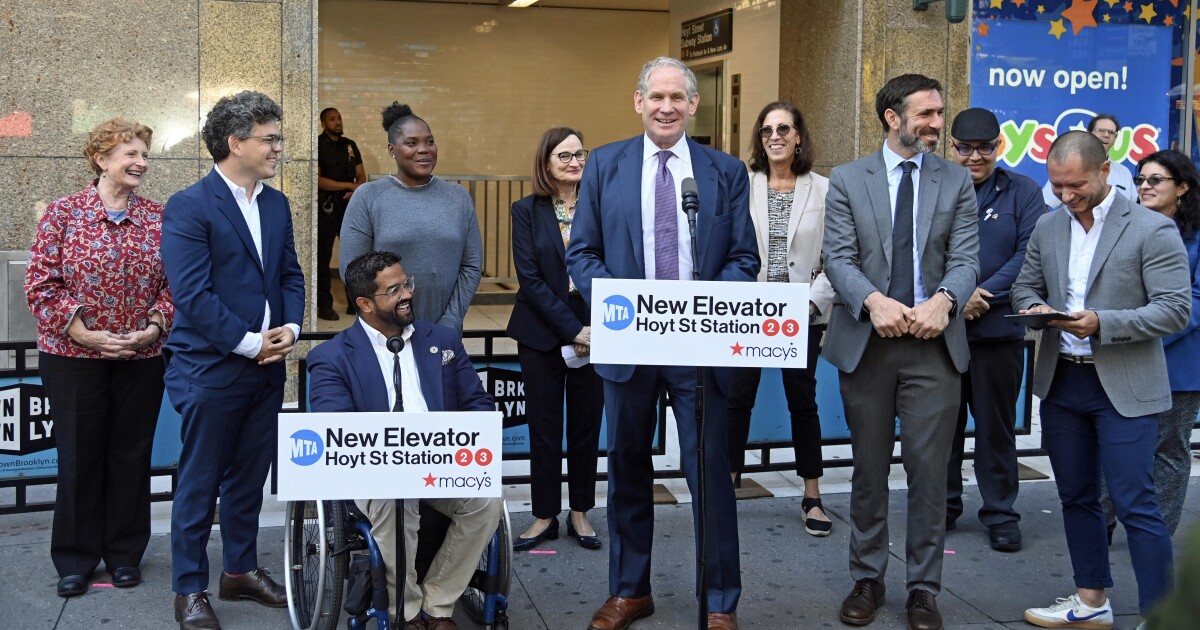Amid rising debt, New York MTA aims to keep accessibility promises
6 min read

Dustin Jones’ story captures the inability of New York’s public transit agency to serve a significant portion of the public.
Trying to take the subway to a meeting of the Center for the Independence of the Disabled, New York, in 2017, Jones, a wheelchair user, couldn’t enter the 5 train, which went directly from his location to CIDNY’s meeting site in Union Square, because there was no elevator access to the station.
That’s not the biggest problem; Jones is used to transferring trains.
Marc A. Hermann / MTA
But when he reached Union Square, he learned the elevator on his platform was broken. He asked an employee when it would be back in service, and was told to get back on the train and try the next stop. When he said the next stop had no elevators, the employee asked, “What do you want me to do?”
Jones asked a bystander to carry his wheelchair up the stairs for him, while he hopped up the steps. Once he reached the mezzanine, other passengers helped him into his wheelchair.
His experience underscores the challenges disabled users face to use New York’s subway. Thirty-three years after the Americans With Disabilities Act was signed, less than 30% of subway stations are accessible.
This year, the MTA settled a pair of lawsuits by pledging to pick up the pace on elevator construction and accessibility. But that agreement comes in the face of significant financial stress and a poor track record for delivering capital projects on schedule and on budget.
In 2017, the MTA had elevators at less than a quarter of its stations, and one in 20 elevators was broken at any given time.
The MTA in the April settlement committed to spend nearly 15% of its capital plan budget on becoming wheelchair accessible.
The MTA committed about 14.69% of its New York City Transit Capital Plan budget to install and maintain elevators in subway stations, around $5 billion. The MTA had 364 inaccessible stations at the time of the settlement; it pledged to make 95% of them ADA-compliant by 2055.
As an example, on the L line only four of its 24 stations had even a single elevator in 2020. It has nine accessible stations today, and the MTA will start construction on four more by the end of the 2024 capital plan, Quemuel Arroyo, the MTA’s chief accessibility officer, said at its September board meeting.
That means “closing that gap from five to 10 stations in between an accessible stop to four or fewer,” Arroyo said.
The MTA has been upgrading 10 stations per year to full accessibility since 2020, compared to just four per year previously, MTA Construction and Development President Jamie Torres-Springer said at the authority’s capital plan meeting.
The age of New York’s subway system is often cited for its failure to accommodate wheelchair users — only three of its stations opened after the Americans With Disabilities Act was signed in 1990.
But it remains well behind its American peers with older systems — the Chicago Transit Authority reports that 70% of its rail stations are accessible. In Boston, the Massachusetts Bay Transportation Authority reports that all but one of its 53 Red, Orange and Blue line subway stations are accessible.
The number in New York: 130 out of 472 subway stations.
The agency’s previous slow pace means that it has a lot of ground to cover.
The MTA agreed in the settlement to make 81 stations accessible from 2020 to 2024, and an additional 80-90 stations every 10 years following until 2055.
When selecting stations for elevators, the MTA will consider factors including geographic coverage, ridership volume, and the senior and disabled population of the region.
The settlement provides for situations where the MTA’s budget falls below certain thresholds. If the budget for the MTA’s capital plan falls below $35 billion, it only has to allocate 12% of its budget to accessibility rather than 14%; if it falls below $30 billion, it can allocate only 10% of its budget.
“The only way that the MTA does not invest this level of money is if they don’t get a fully funded capital plan, which will be catastrophic because then the system is falling apart,” Arroyo said.
The authority’s recently approved and in some quarters controversial congestion pricing plan to toll vehicles entering lower Manhattan was a necessity to fund the projects, Arroyo said, because the capital plan’s budget may have fallen below the threshold for accessibility investments without it.
Since 2012, the New York Metropolitan Transportation Authority has sold almost $41 billion of bonds.
The amount of outstanding long-term debt issued by the MTA more than tripled between 2000 and 2020, according to New York State Comptroller Thomas DiNapoli. As of Sept. 14, total debt outstanding was $49.2 billion, the MTA reports.
If the MTA fails to meet its deadlines — 81 new accessible stations by 2024, 85 by 2035, 90 by 2045 — it must discuss its efforts with the plaintiffs.
“The beauty of our agreement is the MTA can’t say, ‘Well, this isn’t so much a priority. We don’t have enough money to do this, so maybe next year,'” said Joe Rappaport, whose group, the Brooklyn Center for Independence of the Disabled, was one of the plaintiffs. “They can’t do that anymore.”
The MTA has completed 23 of 67 stations in its 2024 capital plan, with six more planned for completion this year, MTA project manager William Montanile testified at the MTA’s September meeting. There are 28 stations with upgrades under construction and 11 planned openings in 2024.
The remainder of the 81 required stations are stations that the MTA planned but did not build under previous capital plans. It has completed 11 of these.
The agency has been experimenting with finding cheaper and faster methods for project delivery, Montanile said. In one case, a contractor constructed an elevator offsite and placed it in a station with a crane, delivering a project within 18 months.

The MTA is also experimenting with other methods of funding its elevators. New York passed Zoning for Accessibility policies in 2021, which incentivize developers to build and maintain elevators, and recently developed public-private partnerships for elevator installation.
“The person who designs and builds these elevators for us, they maintain it as well,” Arroyo said. “If they don’t meet [96.5% availability], they won’t get paid.”
But the MTA’s penchant for missing deadlines is still visible in its accessibility goals.
Work at the 149th Street Grand Concourse complex was delayed to the fourth quarter of 2024 because, among other problems, the MTA realized the station would have no area of refuge for wheelchair users in case of fire, Montanile said. Renovating a building without adding an area of refuge would be a violation of the ADA — the law driving the MTA to install elevators in the first place.
The settlement does not mean the MTA is in the clear from disability activists.
The Brooklyn Center for Independence of the Disabled is suing the MTA because its elevators are out of service about 5% of the time. In Boston, Rappaport said, elevators are only out of service around 1-2% of the time. The law requires that the elevators operate 96.5% of the time and have alternate modes of transportation for when the elevators are out of service.
Arroyo said that the MTA’s elevators meet the legal threshold, and noted that not only do the elevators receive heavy use, the subway runs 24 hours a day. Unlike other cities, Arroyo argued, the MTA can’t schedule maintenance for when the subway isn’t running.
The MTA is also being sued over its paratransit system, Access-a-Ride. The system, where people with disabilities can schedule transportation, has been criticized as convoluted by riders and the Department of Justice.
Riders nicknamed the service “Stress-a-Ride,” according to Jeff Peters, director of communications for CIDNY. To use the service, riders must schedule rides a day in advance. Drivers show up at unpredictable times, and riders don’t always know in advance how many stops their driver will make or how long their trip will last.
The MTA said Access-a-Ride’s service is improving and rider satisfaction is at 76%.
Rappaport noted the MTA fought the 2017 lawsuit to put elevators in its subways.
“Before the settlement, they said they were doing a great job, too. Unfortunately, lawsuits often make a big difference.”
Recently, Rappaport was celebrating the settlement with some of the other plaintiffs and discussing the ongoing lawsuit about elevator maintenance.
One of the plaintiffs, Sasha Blair-Goldensohn, left to go to his job. An hour later, Rappaport got a text from Blair-Goldensohn: a photo of a broken elevator.
He was trapped in the subway.







